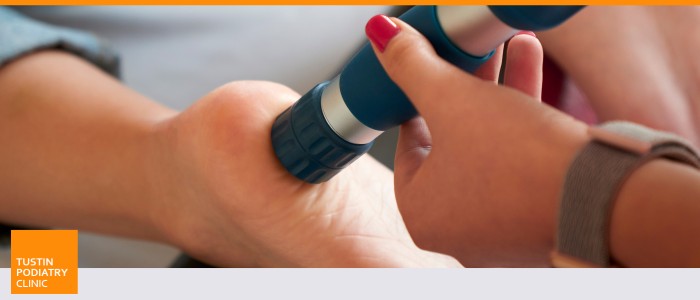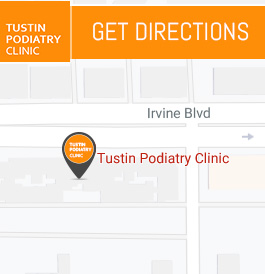Cost of Shockwave Therapy in Tustin, CA
Dr. Charles Baik, DPM provides advanced shockwave therapy to treat various foot and ankle conditions, such as plantar fasciitis and Achilles tendonitis at Tustin Podiatry Clinic. Shockwave therapy is a non-invasive procedure designed to promote healing and reduce pain. The cost of the treatment can vary based on the number of sessions required and the severity of the condition. To receive detailed pricing and a personalized consultation, patients are encouraged to visit us. For more information, contact us today or schedule an appointment online. We are conveniently located at 17400 Irvine Blvd. Suite H, Tustin, CA.


Table of Contents:
What does shockwave therapy do?
How effective is shockwave therapy?
Who is a suitable candidate for shockwave therapy?
How much does Shockwave treatment cost?
How many Shockwave sessions do I need? How often are the treatment sessions?
Is Shockwave covered by Insurances?
At Tustin Podiatry Clinic, Dr. Baik uses the principles of shockwave therapy to introduce shockwaves into the affected areas. This promotes improved blood flow, stimulates cell metabolism, and enhances the formation of new blood vessels. The waves also stimulate cells essential for bone and connective tissue healing, breaking down injured tissues and scar tissue to improve flexibility as well as range of motion.
Shockwave therapy is an effective method for alleviating pain and reducing inflammation. At our clinic, we maximize these benefits to expedite the healing process for our patients. The therapy promotes tissue regeneration, activates the production of growth factors essential for tissue repair, and helps reduce scar formation – all of which lead to improved overall function of the foot and ankle.
Clinical studies have demonstrated successful patient outcomes in 70 to 90 percent of cases, making shockwave therapy particularly effective when traditional treatment methods have failed. This therapy is also successful in promoting the healing of fractures and addressing bone necrosis, both of which are relevant in foot and ankle medicine.
Shockwave therapy works through various mechanisms of action. It triggers the release of pain-reducing substances like endorphins and stimulates the formation of new capillaries, improving blood flow and reducing inflammation in the foot and ankle area. This therapy promotes the production of tissue growth factors, facilitating the repair of various damaged tendons and ligaments as well as other soft tissues in the foot.
Shockwave therapy treats conditions like chronic tendinitis in areas such as the heel, which is common in podiatry. It is also effective for treating plantar fasciitis, a painful condition capable of affecting the foot’s arch. Another common podiatric issue that can be addressed with shockwave therapy is Achilles tendinitis, an inflammation of the Achilles tendon.
Shockwave therapy can speed up the healing process for certain wounds or injuries that are slow to heal. This can be uniquely beneficial among individuals with conditions like diabetic foot ulcers, a common issue in podiatry.
Those who have been experiencing persistent pain for at least six months and haven’t responded to conservative treatment methods may be suitable candidates for shockwave therapy. It’s crucial to have normal vascular and neurological function in the affected area, and an absence of open wounds, infections, and skin conditions. Good overall health with no contraindications to shockwave therapy is also important.
Specific Considerations:
• Age: Shockwave therapy is generally safe for adults of all ages.
• Pregnancy: It’s not recommended during pregnancy.
• Corticosteroid injections: Individuals who have recently received these injections may need to wait before undergoing shockwave therapy.
• Medications: Some medication use may affect the safety of shockwave therapy.
• Underlying health conditions: Individuals with certain health conditions may require additional medical clearance before treatment.
For one area, the cost is $200 per treatment and for two areas, the cost is $300 per treatment.
• For mild or acute cases, we typically need 3-5 weekly treatment sessions
• For moderate/ severe or chronic cases, we typically need 6 weekly treatment sessions.
There are no insurances (except for some Worker’s Compensation cases) that cover the treatment although the treatment is FDA compliant and there is a plethora of scientific data supporting the use of Shockwave.
However, there are some payment options that can help such as Health Savings Account (HSA) or Flexible Spending Account (FSA).
How much does a session of shockwave therapy cost?
The cost of shockwave therapy is variable and influenced by several factors. The type of conditions being treated is one of them. For instance, the cost of treating conditions like plantar fasciitis or Achilles tendinitis, which are common in podiatry, would differ from procedures like Extracorporeal Shock Wave Lithotripsy (ESWL) used to treat kidney stones.
The type of equipment used at our clinic can also impact the final cost. Different types of shockwave therapy machines may be used, and their costs can vary.
The number of sessions required, generally ranging from three to five but can be more based on the severity of the condition, can also affect the total cost. Dr. Baik’s experience and qualifications can also influence the cost. The level of his expertise and the quality of care provided at our clinic can have an impact on the pricing.
We might also add fees for consultation, follow-up visits, or any necessary accessories.
Insurance coverage is a critical point to consider. Shockwave therapy is not typically covered by insurance, so patients are advised to confer with their insurance providers to determine their coverage and potential out-of-pocket costs before undergoing treatment at our clinic.
In terms of specific figures, the cost of a single shockwave therapy session can range from as low as $50 to as high as to as high as $1,500. However, the total costs associated with a complete treatment plan could be higher, as multiple sessions are often recommended. It’s best to consult with the chosen practice for a more accurate cost estimate.
Is shockwave therapy covered by insurance?
Insurance coverage for treatments like shockwave therapy largely depends on the specific condition that is being treated, the patient’s type of insurance plan, and the individual insurance carrier’s policies. For instance, many insurance plans consider shockwave therapy for conditions like plantar fasciitis and heel spurs as a standard treatment and will cover it. However, coverage for other conditions can vary as the treatment might be considered experimental or not standard.
Most commercial insurance plans provide coverage for shockwave therapy when it is deemed medically necessary by a professional, although prior authorization may be required. Medicare may also cover shockwave therapy for certain conditions, such as plantar fasciitis, if conservative treatments have been unsuccessful. Medicaid coverage for this therapy varies on a state-by-state basis. We serve patients from Tustin CA, Irvine CA, Garden Grove CA, Orange CA, Anaheim CA, Costa Mesa CA, Lake Forest CA and BEYOND!

Additional Services You May Need
▸ Heel Pain Treatment
▸ Laser Fungal Nail Treatment
▸ Ingrown Toenail Treatment
▸ Ankle Sprain Treatment
▸ Foot and Ankle Medicine & Surgery
▸ Orthotics Custom
▸ EPAT/Shockwave Therapy
▸ Hammertoe
▸ Arthritis Treatment
▸ Diabetic Foot Care
▸ Flat Feet Treatment
▸ Foot Warts Treatment
▸ ClarixFlo





